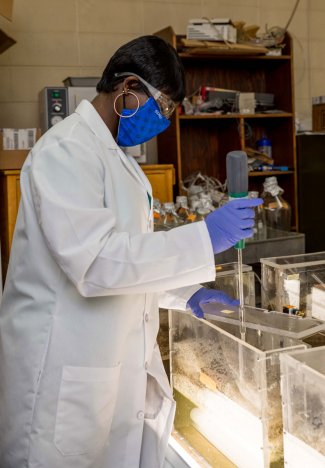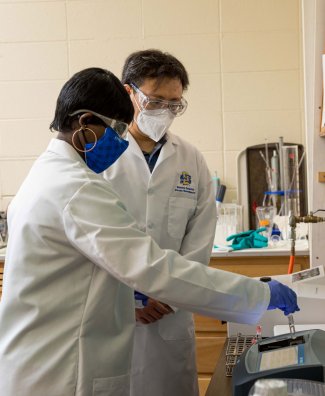Swine manure is a rich source of nutrients, but its high phosphorus content in comparison to the other nutrients the crop needs means only so much can be spread on a field.

Professor Gary Anderson of SDSU’s Department of Agricultural and Biosystems Engineering is investigating the use of algae to reduce phosphorus in the liquid waste streams from swine units and make field application easier. In addition, he also hopes to utilize the algae to remove carbon dioxide and ammonia from indoor and exhaust air.
“Swine waste contains higher quantities of phosphorus than the crop needs relative to the other nutrients. If we can remove some of the nutrients, primarily phosphorus, we can have a product that producers can spread on their fields without having to use other supplemental fertilizers,” Anderson said. Furthermore, the phosphorus harvested from the manure mixture could be sold as separate product.
In addition, removing the nutrient pollutants from indoor air will improve the quality of air released from the swine facilities and help reduce the odor.
Assistant professor Xufei Yang of the Department of Agricultural and Biosystems Engineering, lecturer Kyungnan Min of the Department of Civil and Environmental Engineering as well as agricultural and biosystems engineering doctoral student Augustina Osabutey are also working on the project. The research is supported by U.S. Department of Agricultural hatch funding through the South Dakota Agricultural Experiment Station.
“Basically, we are treating nutrient waste streams to get a neutral product,” Anderson said. “The goal is to take something we have trouble utilizing correctly and make it into a value-added product that will enable producers to reduce or eliminate the costs of the manure processing system.”
Experimenting with algae-manure mixture
“Algae is a biological system of removing nutrients,” explained Anderson, who been working on the project since 2018. The nutrients in the swine manure are used to grow the algae, thereby capturing the phosphorus. When harvested, the algae can be dried and used as a phosphorus supplement.
The algae is grown in a photobioreactor, a closed vessel with a light source. Getting light to penetrate the solution is one of the problems the researchers must overcome.
“Algae need light, so we approach that by reducing the solids in the swine waste, diluting the mixture and using higher intensity light,” Anderson said. The research team is currently doing lab-scale batch processing using 5 to 20-liter systems.
The researchers obtain swine waste from the SDSU Swine Research Facility and then determine the pH, chemical oxygen demand, total suspended solids and the level of nitrogen, ammonia, nitrate, nitrite and phosphorus in the manure.
“Once we know what the waste contains, we decide on the dilution ratios,” Anderson said. Liquid containing algae at a specific concentration is then added to the photobioreactor and processed for 14 to 21 days. During that time, the researchers pull samples at specific intervals to evaluate how nitrogen and phosphorus levels, chemical oxygen demand and suspended solids are changing and to measure algae biomass production.
Currently, the researchers are using an algae species that readily consumes ammonia, but other high-value species, such as those that can be used to produce biodiesel and jet fuel, can also be evaluated in future testing.
Improving air quality

In addition to using nutrients from the manure, the researchers have also examined using the ammonia and carbon dioxide present in air from the manure pit to grow algae in the photobioreactor.
“A pump pulls the air through a tube that runs about 12 inches below the floor slats, thus drawing in the most contaminated air,” Anderson said. The manure pit is underneath the floor slats.
The air moves through a filter that removes dust and then through the sparger, which injects or bubbles the gas into the photobioreactor’s water and algae mixture. In addition to the carbon dioxide becoming available to the algae, the ammonia also ionizes in the water producing ammonium which is the nitrogen source preferred by algae, Anderson explained.
In 2018 and 2019, visiting scientist Seyit Uguz, who is working on his doctorate at Uludag University in Turkey, designed and tested a photobioreactor system that uses nutrients from the swine facility air to grow algae. He ran the system at SDSU’s swine facility for three weeks collecting data on carbon dioxide and ammonia consumption as well as algae growth.
Though Anderson and Uguz are still analyzing the data, the results are encouraging. “First, nothing in the hog house killed the algae,” Anderson said. “Second, filtering the dust eliminated any plugging issues in the sparger, and third, the algae was consuming the carbon dioxide and ammonia from the hog house air and the biomass was increasing.”
After the air bubbles through the photobioreactor, it can be exhausted or, after removing moisture from the air, can be recirculated into the building during the winter, Anderson said. “Recirculating the warm air (in the winter) will help save energy costs.”
If the results from the liquid manure experiments are promising, Anderson hopes to combine the two systems this summer. The combined system has the potential to reduce waste management costs through the harvesting of value-added products.
Republishing
You may republish SDSU News Center articles for free, online or in print. Questions? Contact us at sdsu.news@sdstate.edu or 605-688-6161.

